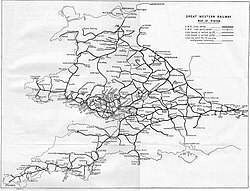Tyseley TMD
 Tyseley Traction Maintenance Depot (top); Tyseley Locomotive Works (around the turntable); and carriage sidings | |
 | |
| Location | |
|---|---|
| Location | Tyseley, Birmingham, England |
| Coordinates | 52°27′19″N 1°50′41″W / 52.4552°N 1.8447°W |
| OS grid | SP105842 |
| Characteristics | |
| Operator | West Midlands Trains |
| Depot code | TS (1973-)[1] |
| Type | DMU |
| History | |
| Opened | 1908[2] |
| Former depot code | |
Tyseley TMD is a railway
.Origins
To counter the critic of the
History
GWR: TYS/174
The North Warwickshire Line came into operation from 1908, and the GWR immediately adopted it and ran all services. However, its major depot in the area was at
Its existing locomotive depot at
The final facility which opened in July 1908, was similar in design to other large GWR depot facilities, such as the original four turntable layout at Old Oak Common. The twin 65 feet (20 m) turntables gave access to 28 roads each of varying length, each with an inspection pit, in total capable of accommodation up to thirty-six tender engines and twenty-eight tank engines.
Most major express trains ran north and terminated or changed engines at
Allocated 72 engines on opening in 1908, it fulfilled both local services as well as those heading south from Tyseley South Junction and Bearley to Stratford-upon-Avon, Cheltenham, Gloucester, Bristol, South Wales and the West Country.
The GWR shed code was TYS.[3]
British Railways: 84E

Post nationalisation in 1948, locomotive numbers rose till by the mid-1950s there were 100 engines allocated, a mix of former GWR,
This marked the height of the depot, and beyond this point much of the site was in decline, in part as from 1963 the depot became allocated to the
When British Railways allocated depot codes in 1949 (based on the former LMS system), Western Region depots were numbered between 81 and 89, and Tyseley was given the code 84E. Following transfer to the London Midland Region, the depot was given the code 2A in September 1963.[3][4]
British Rail
In 1987, the depot had an allocation including
Tyseley Locomotive Works
With the demise of steam on BR in the summer of 1968, the passenger roundhouse was demolished in the same year, with plans to do similar to the coal stage. However, Patrick Whitehouse the new owner of No.7029 Clun Castle negotiated a lease bid, with plans to adapt it for steam locomotives. This and the fact that Birmingham City Council placed a preservation order on the turntable managed to create a strip of land inside the depot, that today is the Tyseley Locomotive Works.
Present

After the
Incidents
On 14 December 2019 Abdul Rehan, a West Midlands Trains driver, died after being caught between two Class 172/3 DMUs that another driver was attempting to couple together. The Rail Accident Investigation Branch determined that WMT had insufficient safe working practices for drivers in depots (especially walking between trains), and also that Rehan had not used the authorised walkway.[9][10][11] An inquest in March 2022 returned a verdict of accidental death.[11]
See also
References
- ^ a b c "The all-time guide to UK Shed and Depot Codes" (PDF). TheRailwayCentre.com. 5 May 2006. Archived from the original on 17 December 2013. Retrieved 27 August 2016.
{{cite web}}: CS1 maint: unfit URL (link) - ^ a b "A Brief History of Tyseley Shed". warwickshirerailways.com. Retrieved 27 August 2016.
- ^ a b c Lyons 1974, p. 141
- ^ Teal 1985, pp. 8, 31
- ^ Marsden 1987, p. 113
- ^ Webster, Greengrass & Greaves 1987, p. 83
- Rail Magazine. No. 476. 10 December 2003.
- ^ "CrossCountry targets Turbostar reliability". Modern Railways. No. 870. March 2021. p. 84.
- ^ Horgan, Rob (8 October 2020). "Operator told to improve depot safety after driver killed between two trains". New Civil Engineer. Retrieved 14 July 2021.
- ^ "Report 09/2020: Fatal accident at Tyseley depot". GOV.UK. Retrieved 14 July 2021.
- ^ a b "Tyseley rail death: Train inquest finds no explanation for crush path". BBC News. 28 March 2022. Retrieved 28 March 2022.
Sources
- Baker, S.K. (2001). Rail Atlas Great Britain & Ireland. ISBN 0-86093-553-1.
- Lyons, E.T. (1974) [1972]. An Historical Survey of Great Western Engine Sheds 1947. Headington: Oxford Publishing Co. ISBN 0-902888-16-1.
- Marsden, Colin J. (1987). BR Depots. Motive power recognition. Vol. 6. OCLC 18685680.
- Teal, Paul (1985). BR Motive Power Allocations 1959-1968 - 1: BR Standards & Austerities. Shepperton: ISBN 0-7110-1540-6.
- Webster, Neil; Greengrass, Robert; Greaves, Simon (1987). British Rail Depot Directory. Metro Enterprises Ltd. OCLC 20420397.
Further reading
- "Tyseley DMUs". OCLC 49957965.
- Knight, Steve (January 1986). "Tyseley: Just another DMU depot?". OCLC 49957965.
External links
An overhead view of the depot, the museum & the carriage sidings.

